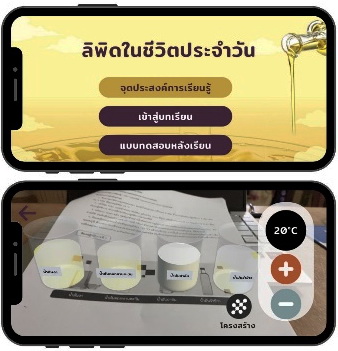การพัฒนาสื่อนวัตกรรมการเรียนรู้โดยใช้เทคโนโลยีความเป็นจริงเสริมเพื่อส่งเสริมมโนทัศน์ทางวิทยาศาสตร์ เรื่อง ลิพิด ของนักเรียนมัธยมศึกษาตอนปลาย
Main Article Content
Abstract
Saovanit Kitcharoenpanya and Sairoong Saowsupa
รับบทความ: 6 กรกฎาคม 2567; แก้ไขบทความ: 24 ตุลาคม 2567; ยอมรับตีพิมพ์: 14 พฤศจิกายน 2567; ตีพิมพ์ออนไลน์: 10 ธันวาคม 2567
บทคัดย่อ
งานวิจัยนี้มีวัตถุประสงค์เพื่อพัฒนาสื่อนวัตกรรมการเรียนรู้โดยใช้เทคโนโลยีความเป็นจริงเสริมเพื่อส่งเสริมมโนทัศน์ทางวิทยาศาสตร์ เรื่อง ลิพิด สำหรับนักเรียนมัธยมศึกษาตอนปลาย ใช้รูปแบบการวิจัย คือ การวิจัยและพัฒนา (Research and development, R&D) กลุ่มเป้าหมายหลักในงานวิจัยแบ่งออกเป็น 3 กลุ่ม ได้แก่ 1) ผู้ให้ข้อมูล ได้แก่ ครูสอนเคมีและครูสอนชีววิทยาระดับมัธยมศึกษาตอนปลายจำนวน 6 ท่าน 2) ผู้ประเมินสื่อนวัตกรรมการเรียนรู้ ได้แก่ ผู้เชี่ยวชาญด้านเนื้อหาและผู้เชี่ยวชาญด้านการผลิตสื่อการเรียนรู้จำนวน 3 ท่าน และนักเรียนมัธยมศึกษาปีที่ 5 ที่ผ่านประสบการณ์การเรียนเรื่อง ลิพิด มาแล้วจำนวน 15 คน และ 3) นักเรียนกลุ่มทดลอง ได้แก่ นักเรียนมัธยมศึกษาปีที่ 4 จำนวน 1 ห้องเรียน เครื่องมือที่ใช้ในการวิจัย ได้แก่ 1) แบบบันทึกสัมภาษณ์ออนไลน์แบบมีโครงสร้างเกี่ยวกับข้อมูลพื้นฐานและลักษณะสื่อนวัตกรรมการเรียนรู้ที่ผสานเทคโนโลยีความเป็นจริงเสริม 2) สื่อนวัตกรรมการเรียนรู้ที่ผสานเทคโนโลยีความเป็นจริงเสริม 3) แบบประเมินความความเหมาะสมและสอดคล้องของสื่อนวัตกรรมการเรียนรู้ มีลักษณะเป็นแบบมาตราส่วนประมาณค่า (rating scales) 5 ระดับ 4) แบบวัดมโนทัศน์ทางวิทยาศาสตร์ มีลักษณะเป็นแบบปรนัย 2 ระดับ ซึ่งตอนที่ 1 เป็นข้อคำถามชนิดปรนัย และตอนที่ 2 เป็นแบบอัตนัยหรือเขียนอธิบายคำตอบที่เลือกตอบในตอนที่ 1 และ 5) แบบสอบถามความพึงพอใจต่อสื่อนวัตกรรมการเรียนรู้ มีลักษณะเป็นแบบมาตราส่วนประมาณค่า 5 ระดับ ผลการวิจัยพบว่าการประเมินสื่อนวัตกรรมการเรียนรู้โดยผู้เชี่ยวชาญและนักเรียนมีคะแนนเฉลี่ยเท่ากับ 4.73 (SD = 0.41) และ 4.52 (SD = 0.58) ตามลำดับ จัดอยู่ในระดับความคิดเห็นมากที่สุด และประสิทธิภาพของสื่อนวัตกรรมการเรียนรู้ มีค่าดัชนีประสิทธิผลเท่ากับ 0.5112 แสดงให้เห็นว่าสื่อนวัตกรรมการเรียนรู้ความเป็นจริงเสริมนี้สามารถช่วยให้นักเรียนมีมโนทัศน์ทางวิทยาศาสตร์เพิ่มขึ้นร้อยละ 51.12 นอกจากนี้นักเรียนมีความพึงพอใจต่อสื่อนวัตกรรมการเรียนรู้ในภาพรวมมีคะแนนเฉลี่ยเท่ากับ 4.35 (SD = 0.69) จัดอยู่ในระดับความคิดเห็นมาก แสดงให้เห็นว่าเทคโนโลยีความเป็นจริงเสริมมีประสิทธิภาพในการพัฒนามโนทัศน์ทางวิทยาศาสตร์ เรื่อง ลิพิด สำหรับนักเรียนมัธยมศึกษาตอนปลาย
คำสำคัญ: สื่อนวัตกรรมการเรียนรู้ เทคโนโลยีความเป็นจริงเสริม มโนทัศน์ทางวิทยาศาสตร์ ลิพิด
Abstract
This study aimed to develop innovative learning tools using augmented reality (AR) technology to enhance understanding of lipid–related scientific concepts among upper secondary students. Employing a research and development (R&D) approach, the research engaged three key groups: 1) Six chemistry and biology teachers from upper secondary levels as informants, 2) Three content experts and learning media technicians as evaluators of the innovative learning media, along with fifteen 11th–grade students with prior lipid learning experience, and 3) A 10th–grade classroom as participants. Research instruments included: 1) A structured online interview form to capture foundational information and characteristics of the AR–based learning media, 2) The AR–based Innovative Learning Media itself, 3) Evaluation of the media's suitability and consistency using a 5–level rating scale, 4) A science concept test comprising two–tier multiple–choice questions and subjective explanations for selected answers, and 5) A satisfaction questionnaire utilizing a 5–level rating scale. Results indicated high approval from both experts (average score 4.73, SD = 0.41) and students (average score 4.52, SD = 0.58) regarding the effectiveness of the AR learning media. An effectiveness index (E.I.) of 0.5112 demonstrated a notable 51.12% increase in understanding of lipid concepts. Moreover, student satisfaction with the innovative learning media was notably high, averaging 4.35 (SD = 0.69). This research underscores the efficacy of AR technology in improving lipid concept com-prehension among upper secondary students.
Keywords: Innovative learning media, Augmented reality technology, Scientific concepts, Lipids
Downloads
Article Details

This work is licensed under a Creative Commons Attribution-NonCommercial 4.0 International License.
References
Binditowa, S., and Pattanasith, S. (2021). The development of digital lesson on problem solving by applying augmented reality technology for Mathayomsuksa 1 students. Journal of Educational Technology and Communications Faculty of Education Mahasarakham University (JETC) 5(14): 59–71.
Chaimutchim, K., and Chairam, S. (2014). Enhancing Grade–12 students’ understanding of biomolecules using inquiry–based activities. Journal of Research Unit on Science, Technology and Environment for Learning 5(2): 165–175.
Chindanurak, T. (2016). Innovation and media in science teaching and learning in the 21st century. Veridian e–Journal, Silpakorn University (Humanities, Social Sciences and Arts) 9(1): 560–581.
Goodman, R. I., Fletcher, K. A., and Schneider, E. W. (1980). The effectiveness index as a comparative measure in media pro-duct evaluations. Educational Technology 20(9): 30–34.
Ismail, A., Rahayu, G., Putera, M. A. K., Aghniya, N. N., and Gumilar, S. (2021, March). Development of augmented reality as physics learning media on electric concepts. In IOP Conference Series: Materials Science and Engineering (Vol. 1098, No. 4, p.042006). IOP Publishing.
Khan, T., Johnston, K., and Ophoff, J. (2019). The impact of an augmented reality application on learning motivation of students. Advances in Human–Computer Interaction 2019(1): 7208494.
Kitakarn, P., and Phuttiyatanee, S. (2002). Effectiveness Index: EI. Journal of Educational Measurement Mahasarakham University 8: 30–36.
Mazzuco, A., Krassmann, A. L., Reategui, E., and Gomes, R. S. (2022). A systematic review of augmented reality in chemistry education. Review of Education 10(1): e3325.
Ministry of Education. (2017). Learning Standards and Indicators. Learning Area of Science. Basic Education Core Curriculum B.E. 2551 (A.D. 2008). Bangkok: Author.
Montreesree, S., and Sovajassatakul, T. (2019). A development of augmented reality media on animation creation for grade 11 students. Journal of Industrial Education 18(2): 40–47.
Nakasan, N., and Ruangvanich, S. (2016). Augmented reality: Bringing life to educational publications. Romphruek Journal 34(2): 33–50.
The Institute for the Promotion of Teaching Science and Technology [IPST]. (2022). AR and IPST. Retrieved from https://www.myrecall.app/ar-with-IPST/, December 17, 2022.
